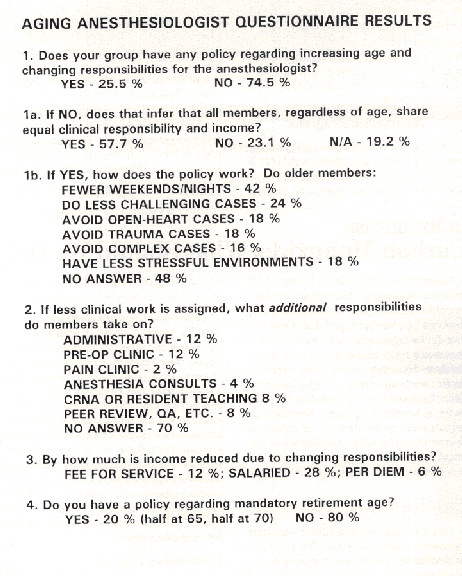As this editorial is being written, Thanksgiving is upon us. It occurs to me that we should give thanks for the success all of us have had in the past decade in making the administration of anesthesia such a safe undertaking. While the progress is truly remarkable, all is not perfect, however. Perhaps it never will be. I am aware of one anesthesia mishap in this country this year which is reminiscent of the early 1980’s in which a breathing system disconnect during mechanical ventilation was unrecognized, resulting in the death of a young man. The anesthesia machine was old and without appropriate alarms.
Today, anesthesia safety covers an ever-broadening range of subject matter. During the last several months there has been correspondence in this Newsletter concerning the role of the aging anesthesiologist. Recently I was asked to speak to an anesthesia society about aging as well as fatigue. In preparing for the talk, I reviewed Dr. David Caba’s chapter on “Human Work Environment and Simulators” in the new edition of Miller’s textbook, which contained a section entitled ‘Aging.’ Everyone should read it.
Also, I was given a list of questions by the society concerning problems they have among their membership in working out solutions in different groups for the anesthesiologists who are getting .older.” On that basis, I prepared a questionnaire and sent it out in a most-unscientific manner to some 75 anesthesiologists.
I received more than 50 replies. For your information, I give you the data. The questions and graphs of the responses are shown. In addition, I received a number of comments, some of which are noted (the comments were not randomly selected).
Kenneth W. Travis, M.D., who initiated the recent correspondence concerning advancing age among anesthesiologists, has written a research grant, much more scientifically designed than my questionnaire, to examine further the role of anesthesiologist aging as it relates to performance and, potentially, patient safety. Hopefully over the next year or two we will have more answers.
Have a safe 1995.
Ellison C. Pierce, Jr., M.D.
President, Anesthesia Patient Safety Foundation


